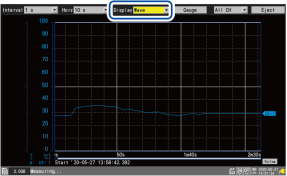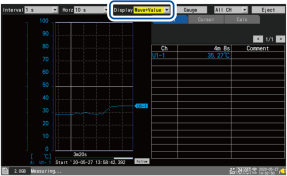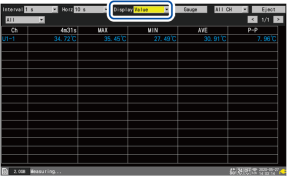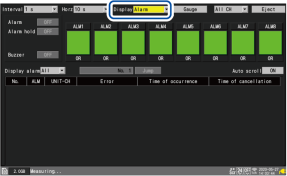Setting Example (Measuring Temperature Using Thermocouples)
This section describes how to configure the settings to measure temperature with the instrument and a plug-in module
You can measure temperature with the following products.
Preparing for measurement
1 Insert storage media.
2 Connect the thermocouple (Type K) to the U1-1 input terminal of the module.
Cable insulation colors vary by country and manufacturer. Check before connecting.
How to operate the instrument
1 Press the SET key to display the [Measure] main tab and the [Record] sub tab.
Set the recording conditions as follows:
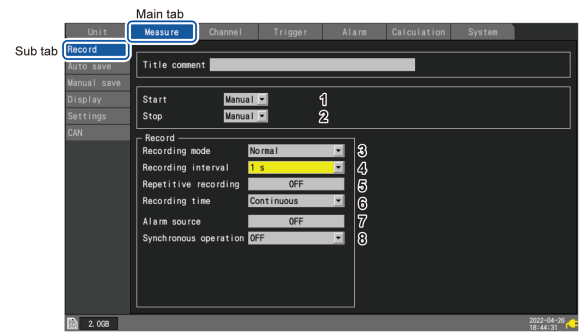
|
No. |
Setting |
Condition |
Description |
|---|---|---|---|
|
1 |
Start |
Manual |
Starts recording when the corresponding key is operated. |
|
2 |
Stop |
Manual |
Stops recording when the corresponding key is operated. |
|
3 |
Recording mode |
Normal |
Fixed. |
|
4 |
Recording interval |
1 s |
Measures temperatures every 1 s. |
|
5 |
Repetitive recording |
OFF |
Disables the repetitive recording. The instrument will perform a series of measurements only once. |
|
6 |
Recording time |
Continuous |
Continues the recording until you press the STOP key. |
|
7 |
Alarm source |
OFF |
Disables the alarm function. |
|
8 |
Synchronous operation |
OFF |
Does not use synchronous operation. |
2 Press the SET key to display the [Channel] main tab and the [Individual] sub tab.
The instrument represents the input channels as Un-m.
n represents the module number; m represents the channel number.
Set the input conditions of U1-1 (Channel 1 of Module 1) as follows:
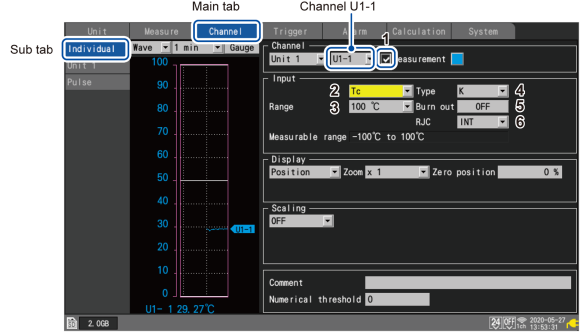
|
No. |
Setting |
Condition |
Description |
|---|---|---|---|
|
1 |
Check box |
|
Performs measurement for channels whose check box is selected. |
|
2 |
Input type |
Thermocouple |
Measures temperature using thermocouples. |
|
3 |
Range |
100°C |
Measures temperature between -100°C and 100°C. |
|
4 |
Type |
K |
Select Type K thermocouple. |
|
5 |
Burn out |
OFF |
Disables the thermocouple wire break detection function. |
|
6 |
RJC |
INT |
Performs the reference junction compensation in the measurement module. |
Switching over to the [Unit 1] sub tab allows you to configure the settings for 15 channels at once.
Clear the check boxes of channels U1-2 to U1-15, exempting the channels from the measurement subjects.
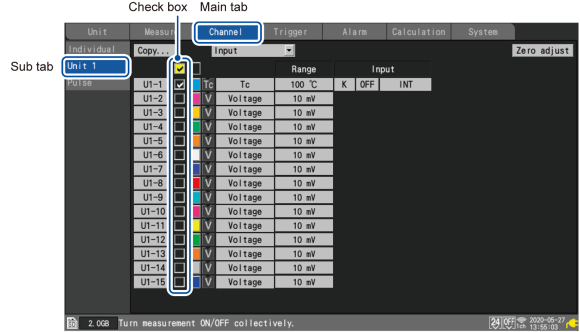
3 Start measurement.
|
|
Press the START key. |
The confirmation window [Start measurement?] will appear.
Select [Yes], and then press the ENTER key to start measurement.
Wave+Set screen
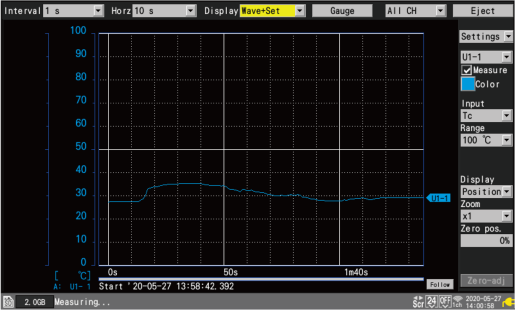
You can use the WAVE key to switch the screen.
|
Wave screen
|
Wave+Value screen
|
|
Value screen
|
Alarm screen
|
When [X-Y Composite] is on, the [XY+Set] and [XY+Value] screens will also be displayed.
“1.15 X-Y Compositing” in the Instruction Manual.
4 Stop measurement.
|
|
Press the STOP key. |
The confirmation window [Stop measurement?] will appear.
Choose [Yes], and then press the ENTER key to stop measurement.
5 Save the measured waveform data.
When you press the SAVE key, the file saving window will appear.
Under [Type], select [Waveform]. Under [Format], select [Binary].
Press the ENTER key while [Save] is selected.

The instrument can load binary-form (LR8450-specific-form) waveform data only.
When you do not name files, the instrument will automatically name them.
6 Load the saved waveform data.
When you press the FILE key, the file list screen will be displayed.
Waveform data is saved in the [HIOKI] > [LR8450] > [DATA] > [yy-MM-dd] folder.
(yy-MM-dd represent the year, month, and date, respectively)
Press the ENTER key while files are selected. The data loading window will be displayed.
Select [OK] and then press the ENTER key. The instrument will load the files.
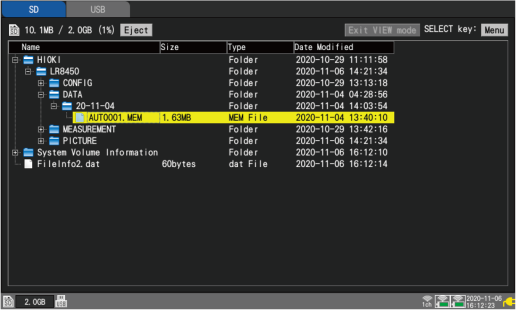
Each data is saved in the following folders:
-
CONFIG: setting data
-
DATA: waveform data
-
MEASUREMENT: numerical calculation results
-
PICTURE: image data


